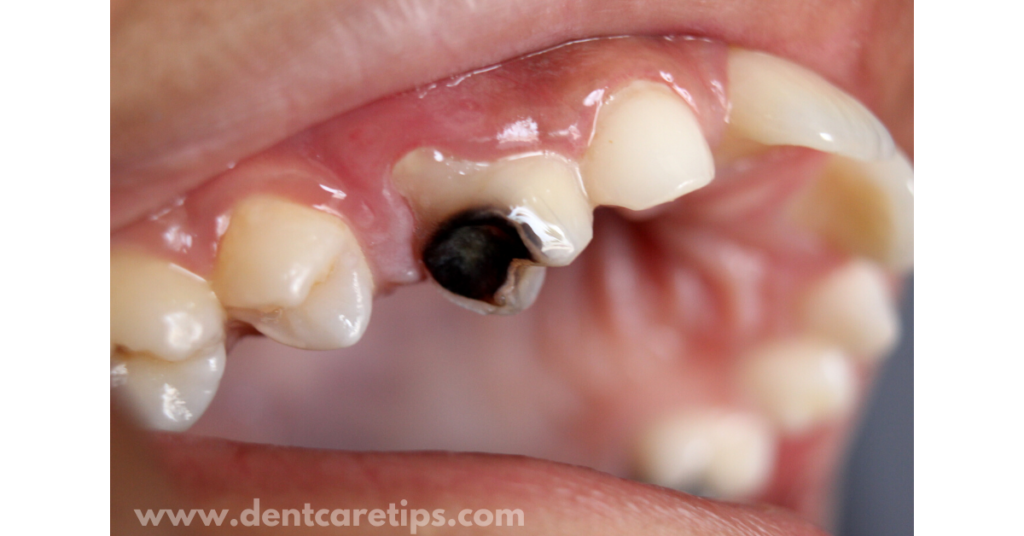A cavity look like a small hole or dip in the tooth because of tooth decay. Cavities can occur at any age. cavities occur mostly due to the presence of bacteria. So every one doubt what does a cavity looks like? There are a lot of signs that help you in identifying whether you have a cavity or not. Actually speaking a dental cavity can differ in color, form, frequency, size Etc, depending on the stage of development of the cavity.

What does a cavity look like in the beginning
1. Black spot on teeth / Discoloration on teeth
The first sign you may notice of a cavity is that it may appear as simple staining or cavity may look like small black spots. You may ignore this as mild discoloration. But over some time it may get larger leading to deeper discoloration and cavity. Cavity looks like brown colored or black color discoloration. Hence you have to consult a dentist to check it out to confirm that it is a natural stain or not.
2. Holes or pits in teeth/ craters on teeth.
Sometimes cavity looks like small pits or holes in the teeth. You might confuse it with the normal anatomy of the teeth. In this small pit or hole, food particles get lodged and lead to bacterial attack and thereby formation of a cavity. Deeper pits can be protected from bacterial attack by getting preventive fillings done.
3. Whitish or chalky appearance on the surface of the teeth.
Sometimes cavity look like small whitish or chalky white spots on the surface of the teeth.
This appearance is found in the initial stages of cavity formation. These white spots are the
areas of decalcification on the teeth. Bacteria can easily invade these decalcified areas leading to the development of the cavity. These kinds of white lesions can be controlled by using fluoride-containing toothpaste.
What does a cavity feel like?
1.Tooth sensitivity
If you experience sensitivity to hot cold or sweet food items that you didn’t have that before
you may suspect the development of cavity in your oral cavity? If the cavity limits to enamel
only you may not experience tooth sensitivity as there is no evidence of nerve ending in enamel
portion of the teeth, but as the cavity gets deeper and extends into the Dentin layer of teeth you
may start experiencing teeth sensitivity. This happens because of the nerve endings that are
present on the Dentin layer of teeth. Enamel layer can be abraded because of excessive
consumption of acidic drinks or due to faulty brushing technique. In these cases also you may
feel tooth sensitivity. So don’t confuse this with cavities.
2. Pain while eating or drinking
At the early stages of tooth decay, you won’t experience any kind of toothache. But in the later stages, you may start experience tooth pain. This is because tooth Decay might have extended into the soft tissue part of the tooth that is called the pulp. The pulpal portion is rich in blood supply. Bacteria present on the decayed portion may enter the bloodstream and circulates through the
bloodstream leading to the presence of infection.
In this stage, you will start getting a toothache . In the initial stages, pain will be present only when
food lodges on the cavity, but later on pain mostly aggravates at night time. In this point
simple filling will not be efficient, So dentist recommends root canal treatment to save the
tooth and for pain relief.
If root canal treatment is not done for pulp with infection, It can lead to the next stage of the
disease that is swelling. First swelling is seen near the tooth on the gums with or without pus
discharge, but on later stages swelling can extend to the face if left untreated. In this stage pus
drainage is ideal to limit the spread of infection.
3. Bad breath
Foul odour from mouth is one of the signs of tooth decay. Bad breath occurs due to food getting food lodgement in the cavity. This can lead to bacterial accumulation. It is difficult to remove food materials lodged into deeper cavities. This can lead to foul odour from mouth
4. Discomfort in the gums
we can see some cavities on the surface adjacent to the next tooth or on the proximal surface of the teeth .In this case food gets indulge into the gums causing gum inflammation or discomfort. some people use toothpicks to remove the food particles, but this can further aggravates gum irritation.
Also Read : How long does it take for a cavity to form
Is it possible to reverse a cavity?
No, it is not possible to reverse a cavity. Once tooth structure loses, It cannot reverts back to normal. We can only slow down the incidence of getting cavities. It is better to consult a dentist and do a necessary dental procedure. The dentist may suggest a feeling if the cavity depth is not extending to the pulp. Once it has reached the pulpit can lead to pulpitis. So filling is not ideal. The dentist may suggest root canal treatment in order to prevent the spread of dental infection.
Who all are at higher risk to develop cavity?
A child with the night time bottle feeding (Sugar content in the milk can lead to the accumulation of bacteria and thereby leading to nursing bottle caries). People living in poor socioeconomic status, People living in areas with a supply of non fluoridated drinking water. Those who are taking drugs and medication that decrease salivary flow have a higher incidence of developing cavities. some with eating disorders like bulimia nervosa. Patients with gastric related problems like hyper acidity GERD etc. People who drink plenty of carbonated drinks and acidic drinks. People who are undergoing radiation therapy. people under radiation therapy have reduced salivary flow resulting in an increased incidence of developing cavities.
How can we prevent cavities? / What are the home remedies to prevent cavities?
A better way to prevent cavities is to maintain better oral hygiene. Some of the measures are as follows
- Brush ties twice daily that are in the morning and before going to bed.
- Along with brushing do flossing to remove the food particles stuck into the gums.
- Reduce the consumption of acidic drinks and excessive sugar-containing sticky Foods. If you want to take acidic drinks, drink with a straw.
- Use sugar-free chewing gums or xylitol-containing chewing gums for those people with the decreased salivary flow. There is an increased incidence of cavities in those with a reduced salivary flow.
- Those people with deeper pits and fissures on the surface of the teeth get a preventive feeling done.
- Avoid in-between snacks
The Bottom Line (What does a cavity look like)
Not every cavity is visible. Just because you can’t see a cavity doesn’t mean that it isn’t there. Some cavities can be visible only through regular dental check-ups and through Dental x-ray. So it is advisable to visit a dentist at least once every six months.

